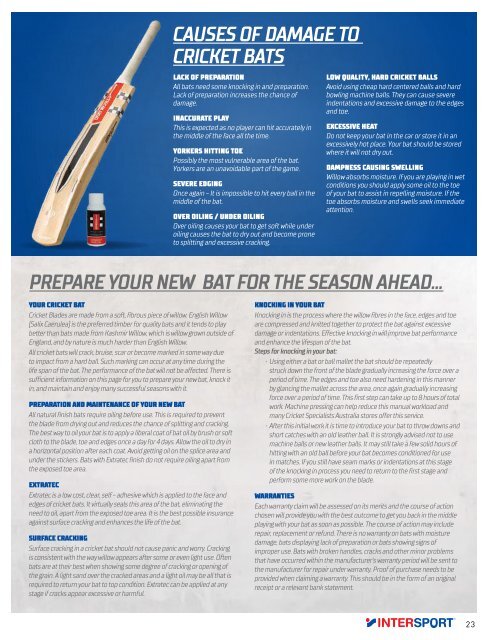IS_Cricket_Catalogue_0519_FA_01_WEB
You also want an ePaper? Increase the reach of your titles
YUMPU automatically turns print PDFs into web optimized ePapers that Google loves.
CAUSES OF DAMAGE TO<br />
CRICKET BATS<br />
LACK OF PREPARATION<br />
All bats need some knocking in and preparation.<br />
Lack of preparation increases the chance of<br />
damage.<br />
INACCURATE PLAY<br />
This is expected as no player can hit accurately in<br />
the middle of the face all the time.<br />
YORKERS HITTING TOE<br />
Possibly the most vulnerable area of the bat.<br />
Yorkers are an unavoidable part of the game.<br />
SEVERE EDGING<br />
Once again - It is impossible to hit every ball in the<br />
middle of the bat.<br />
OVER OILING / UNDER OILING<br />
Over oiling causes your bat to get soft while under<br />
oiling causes the bat to dry out and become prone<br />
to splitting and excessive cracking.<br />
LOW QUALITY, HARD CRICKET BALLS<br />
Avoid using cheap hard centered balls and hard<br />
bowling machine balls. They can cause severe<br />
indentations and excessive damage to the edges<br />
and toe.<br />
EXCESSIVE HEAT<br />
Do not keep your bat in the car or store it in an<br />
excessively hot place. Your bat should be stored<br />
where it will not dry out.<br />
DAMPNESS CAUSING SWELLING<br />
Willow absorbs moisture. If you are playing in wet<br />
conditions you should apply some oil to the toe<br />
of your bat to assist in repelling moisture. If the<br />
toe absorbs moisture and swells seek immediate<br />
attention.<br />
CRICKET / 2<strong>01</strong>9 – 2020<br />
PREPARE YOUR NEW BAT FOR THE SEASON AHEAD...<br />
YOUR CRICKET BAT<br />
<strong>Cricket</strong> Blades are made from a soft, fibrous piece of willow. English Willow<br />
(Salix Caerulea) is the preferred timber for quality bats and it tends to play<br />
better than bats made from Kashmir Willow, which is willow grown outside of<br />
England, and by nature is much harder than English Willow.<br />
All cricket bats will crack, bruise, scar or become marked in some way due<br />
to impact from a hard ball. Such marking can occur at any time during the<br />
life span of the bat. The performance of the bat will not be affected. There is<br />
sufficient information on this page for you to prepare your new bat, knock it<br />
in, and maintain and enjoy many successful seasons with it.<br />
PREPARATION AND MAINTENANCE OF YOUR NEW BAT<br />
All natural finish bats require oiling before use. This is required to prevent<br />
the blade from drying out and reduces the chance of splitting and cracking.<br />
The best way to oil your bat is to apply a liberal coat of bat oil by brush or soft<br />
cloth to the blade, toe and edges once a day for 4 days. Allow the oil to dry in<br />
a horizontal position after each coat. Avoid getting oil on the splice area and<br />
under the stickers. Bats with Extratec finish do not require oiling apart from<br />
the exposed toe area.<br />
EXTRATEC<br />
Extratec is a low cost, clear, self - adhesive which is applied to the face and<br />
edges of cricket bats. It virtually seals this area of the bat, eliminating the<br />
need to oil, apart from the exposed toe area. It is the best possible insurance<br />
against surface cracking and enhances the life of the bat.<br />
SUR<strong>FA</strong>CE CRACKING<br />
Surface cracking in a cricket bat should not cause panic and worry. Cracking<br />
is consistent with the way willow appears after some or even light use. Often<br />
bats are at their best when showing some degree of cracking or opening of<br />
the grain. A light sand over the cracked areas and a light oil may be all that is<br />
required to return your bat to top condition. Extratec can be applied at any<br />
stage if cracks appear excessive or harmful.<br />
KNOCKING IN YOUR BAT<br />
Knocking in is the process where the willow fibres in the face, edges and toe<br />
are compressed and knitted together to protect the bat against excessive<br />
damage or indentations. Effective knocking in will improve bat performance<br />
and enhance the lifespan of the bat.<br />
Steps for knocking in your bat:<br />
• Using either a bat or ball mallet the bat should be repeatedly<br />
struck down the front of the blade gradually increasing the force over a<br />
period of time. The edges and toe also need hardening in this manner<br />
by glancing the mallet across the area, once again gradually increasing<br />
force over a period of time. This first step can take up to 8 hours of total<br />
work. Machine pressing can help reduce this manual workload and<br />
many <strong>Cricket</strong> Specialists Australia stores offer this service.<br />
• After this initial work it is time to introduce your bat to throw downs and<br />
short catches with an old leather ball. It is strongly advised not to use<br />
machine balls or new leather balls. It may still take a few solid hours of<br />
hitting with an old ball before your bat becomes conditioned for use<br />
in matches. If you still have seam marks or indentations at this stage<br />
of the knocking in process you need to return to the first stage and<br />
perform some more work on the blade.<br />
WARRANTIES<br />
Each warranty claim will be assessed on its merits and the course of action<br />
chosen will provide you with the best outcome to get you back in the middle<br />
playing with your bat as soon as possible. The course of action may include<br />
repair, replacement or refund. There is no warranty on bats with moisture<br />
damage, bats displaying lack of preparation or bats showing signs of<br />
improper use. Bats with broken handles, cracks and other minor problems<br />
that have occurred within the manufacturer’s warranty period will be sent to<br />
the manufacturer for repair under warranty. Proof of purchase needs to be<br />
provided when claiming a warranty. This should be in the form of an original<br />
receipt or a relevant bank statement.<br />
28<br />
23









